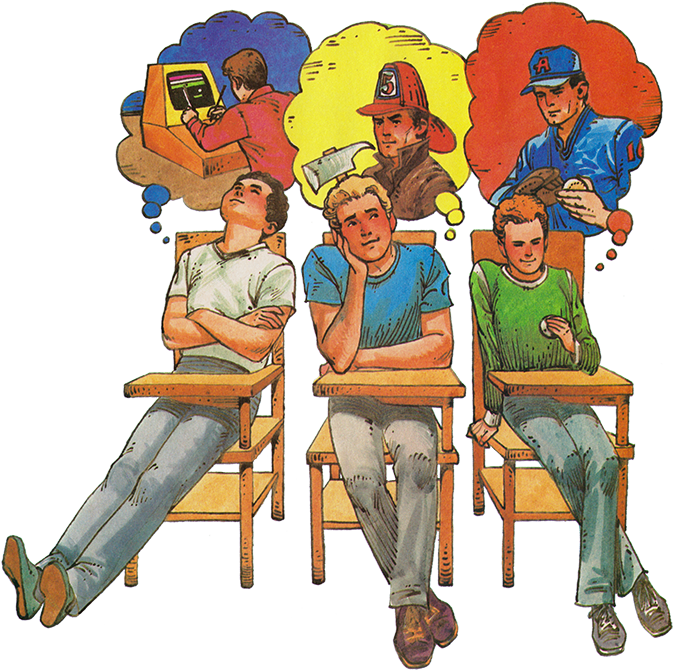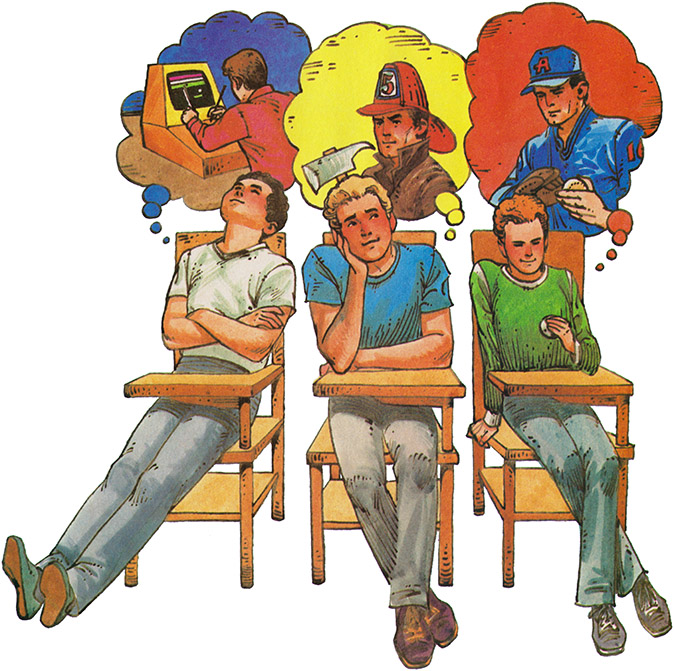
You Can Become A Game Designer
Plan Now for a Career in Gaming
Twenty years ago it was fantasy: cowboys or soldiers or space cadets. Today it’s fantasy plus: video lassos, 3-D tank battles, hands-on space warfare. Now, for almost every dream there’s an electronic game that makes the dream a reality.
Still, some have other dreams. Their minds are agile, their fingers deft. Their eyes see two moves ahead. And yet to certain game players, play alone is not enough. The physical and mental challenge of marathon game sessions leaves them fascinated by the ultimate video wizard: the electronic game designer.
They are curious: “How would I do it?” or confident: “I could do it better.” But where do they go from there? How do you turn a spark of creativity into bomb bursts and laser blasts? Here are some answers, some suggestions and some advice. Here is a peek behind the scene into a career that could only exist in the twentieth century.
Let’s start with basics. Education tops the list.

Some game designers have a solid technical education. Specialties differ, but the focus is on the hard sciences. For example, the creative team that produced Midway’s Tron includes four designers with masters degrees in electrical engineering, computer science and industrial art. Ace Atari designer Chris Crawford (Eastern Front, Scram) and Silas Warner (Robot War, Castle Wolfenstein) of MUSE were both physics majors.
Other people come to design with backgrounds in english, art and music. Don’t be surprised to find that the field has its share of MBAs and accountants. Game designing is a business. While a designer must know a bit about bytes and number crunching, some of the most important numbers are dollars and cents. Balance sheets and budgets may not strike you as glamorous (you’re probably right), yet they are as much a part of game designing as color and sound.
Knowledgewise, the bottom line in this profession is computer programming skill. Programming is the art of How do you develop “hard” and “easy” versions of the game? The designer must answer questions like these first.
The next step is translating the answers into a language a computer understands. This language is called a programming language. Several languages exist. BASIC, COBOL and FORTRAN are well known examples. Virtually every arcade or home videogame is programmed in a language called “assembler”. Assembler language is not for the fainthearted. Assembler programs are difficult to write and twice as hard to read. Imagine trying to make sense of 10 pages of cryptic statements like:
LIM DC1, BUFA
LOOP LNA DCO
SNA DC1
Unlike humans, computers have no problem following assembler instructions. Using assembler, designers write short, efficient programs that run extremely fast on the microcomputers inside today’s games. The result is the sure sign of quality programming: smooth animation and rapid player response.
Fine you say. Where do I learn more about programming and micros? Try universities and colleges.
Most institutions offer degrees in computer science. A B.A. or M.A. in computer science is an excellent springboard to a career in game designing. Are you in college now? Talk to your advisor. Take some electives in programming, electrical engineering and math. Out of college? Don’t worry. Graduate and undergraduate courses are usually available to the interested. Aim for courses that teach microprocessor fundamentals and assembler programming.
Another possibility: computer stores and computer users’ groups. Both provide formal and informal sources of information on programming micros. You will meet professionals and talented amateurs who may have the same interests.
What about commercial programming schools?
Be careful here. These schools train people for jobs in business, not the entertainment industry. The emphasis is on data processing. Basically, you get a practical preparation for jobs in banks and insurance companies. Do not expect instruction on computer graphics or playfield mechanics. Your training will be shorter, faster and less comprehensive than college course work. If you decide to go this route, check the school’s placement records and its standing with the Better Business Bureau.
Alright. You’ve got a glimpse of the training needed by game designers. You might be thinking: “I guess it’s time for the fun part.”
Guess again.
Playing videogames is fun. Designing them is serious work. Some people think designing a game is only slightly harder than having a bright idea. Like film studios and TV networks, electronic game companies have files packed with unsolicited brainstorms from eager (but unknown) creative geniuses. Four-page essays describing the exquisite details of a videogame are about as popular as letter bombs. Words count a lot less than knowing how to translate ideas into action and strategy.
In order to design games, the ability to think logically and keep track of details is essential. “Don’t underestimate the planning that goes into designing a videogame,” advises John Pasierb.
He should know. As Vice President of Engineering for Bally Midway, Pasierb has been involved in developing arcade classics like Galaxian and Omega Race. “Everyone thinks they know how to design games,” says Pasierb. “But there are many, many elements to game designing and there’s no formula for creating successful ones.”
A skilled designer can identify these elements. And, according to Pasierb, this critical eye for what works and what doesn’t can be developed with practice on the job.
To illustrate, Pasierb cites details the average game player takes for granted: the size of objects on the playfield (asteroids, ghosts); the choice of control options (button or joystick); the range of movement of the onscreen player (unlimited, fixed).
A game creator is more than a technician. A designer should be able to communicate; to explain his ideas in terms a non-technical person can understand. At times a designer may need the skill to persuade others, to “sell” an idea he believes in. Occasionally, and this is hard for anyone, a designer must be able to compromise by accepting changes to cherished ideas and visions.
And while we’re on the subject, sensitivity and personality play a key role too. Silas Warner, Manager of Research and Development at MUSE Software believes, “In games design, it’s the human element that counts. The human interface is paramount. It’s important to be a person who knows how to interact with others.”
Warner believes strongly that game designing is the wrong career for people whose lives are focused on computers. Warner thinks that the “hacker”, the programming addict who lives at his terminal, makes a poor designer. “Hackers relate to computers as number crunchers,” adds Warner, “and a game is more than just the numbers inside a machine.”
John Pasierb thinks a designer needs to be flexible, a team player and, above all, highly motivated. People like this, admits Pasierb are a “minority.” What about being a good game player? “Irrelevant” says Pasierb, “Being a good strategist is more important.”
In short, the word is this: To be a game designer you need talent, training, maturity, special skills and a particular kind of personality. The best designers are well-rounded people, not one-sided computer freaks. Instead of burying himself in a terminal, a designer uses the computer as a tool to communicate with and entertain his audience.
Right now the designer is typically an experienced programmer working alone or on a team and creating a single game from start to finish.
But tomorrow?
Explosive consumer demand, corporate competition, more powerful microprocessors, cheaper memory and, perhaps, images stored on videodiscs will change games and game designing into something different, exciting and worth waiting for.
MUSE’s Warner predicts, with some concern, that as the influence of entertainment conglomerates grows, we will see the development of “assembly line” games design. Other experts foresee the use of special tools like “author” languages that will permit people with no programming ability to create computer games.
Whatever the future, today one thing is sure: Game designing is in its infancy. Few “right” answers exist. As Silas Warner puts it: “No advice is perfect because it’s all such a new thing.”
Source Pages





